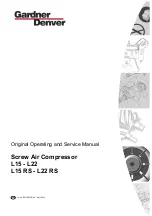
14
AGL_HP_ST_YHK1E_E_Rev02
3.9
Filter screens
CAUTION
Screen blocking! Compressor breakdown!
Use screens with at least
0.6 mm openings.
The use of filter screens finer than 30 x 30
mesh
(0.6 mm openings) anywhere in the system should
be avoided with these compressors. Field experience has shown that finer mesh screens used to
protect thermal expansion valves, capillary tubes or accumulators can become temporarily or
permanently plugged with normal system debris and block the flow of either oil or refrigerant to the
compressor. Such blockage can result in compressor failure.
3.10 Mufflers
Gas flow through scroll compressors is continuous with relatively low pulsation. External mufflers
may not be required on Copeland Scroll compressors. Due to system variability, individual tests
should be conducted by the system manufacturer to verify acceptable levels of sound and vibration.
If adequate attenuation is not achieved, use a muffler with a larger cross-sectional area to inlet area
ratio. A ratio of 20:1 to 30:1 is recommended. A hollow shell muffler will work quite well. Locate the
muffler at minimum 15 cm to maximum 45 cm from the compressor for the most effective operation.
The farther the muffler is placed from the compressor within these ranges, the more effective. Choose
a muffler with a length of 10 to 15
cm.
3.11 Sound shell
At this time, no sound shell attenuation for YH*K1E compressors is available from Emerson. If a
sound shell is still needed, particular attention shall be paid to the electrostatic charge of the
insulation material as it could be a potential ignition source.
3.12 Insulation material
Insulation material is commonly used in a system to insulate the suction line, suction accumulator,
expansion valve bulb or discharge line thermostat. When choosing the insulation material, particular
attention shall be paid to its non-electrostatic properties, as it could be a potential ignition source.
3.13 Sound and vibration
WARNING
Vibrations! Creation of a flammable atmosphere!
Carefully check the
system for vibrations.
Vibrations during compressor operation can cause cracks which could lead to refrigerant leakage.
This situation must be avoided by the system manufacturer/installer. Therefore, the pipework must
be carefully designed when connecting a scroll compressor to a system.
A scroll compressor makes both a rocking and twisting motion
and enough flexibility must be provided in the pipe-lines to
allow starting, stopping and steady state running of the
compressor without transmitting excessive stress into any
line attached to the unit. In a split system, the most important
goal is to ensure minimal vibration in all directions to avoid
transmitting vibrations to the structure to which the lines are
fastened.
Under some conditions, the Copeland Scroll has a normal
starting rotational motion that can transmit a transient noise
along the lines. This may be particularly pronounced in
compressors using a three-phase motor due to their
inherently higher starting torque. This phenomenon, like the
one described previously, can easily be avoided by using
standard line isolation techniques.
The sound level of a system is the result of design, quality and application. Scroll compressors sound
power levels generally increase with the compressor model capacity and the condition pressure ratio.
Figure 12: Example of suction tube design
Содержание Copeland Scroll YH16K1E
Страница 1: ...Copeland Scroll Compressors for Heat Pump Applications YH04K1E to YH16K1E Application Guidelines ...
Страница 4: ...AGL_HP_ST_YHK1E_E_Rev02 9 References 33 DISCLAIMER 33 ...
Страница 5: ......
Страница 39: ...34 AGL_HP_ST_YHK1E_E_Rev02 ...
















































